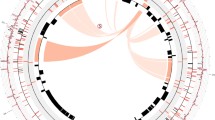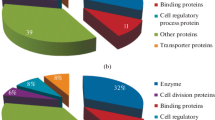Abstract
The Serratia marcescens is a Gram-negative bacterium from the Enterobacteriaceae family. Recently, S. marcescens have evolved to become a versatile and opportunistic pathogen. Furthermore, this bacterium is also a multi-drug resistant pathogen exhibiting Extended-Spectrum Beta-Lactamases (ESBL) activity. This bacterium is highly associated with infections in healthcare settings and even leads to death. Hence, an advanced approach based on non-protein coding RNA (npcRNA) of S. marcescens was considered in this study to understand its regulatory roles in virulence, pathogenesis, and the differential expression of these transcripts in various growth phases of the bacterium. BLASTn search of known npcRNAs from Salmonella typhi, Escherichia coli, and Yersinia pestis against S. marcescens was performed to discover putative conserved homologous transcripts. The novelty of these putative homologous npcRNAs was verified by screening through the Rfam web tool. The target mRNA for the homologs was predicted via the TargetRNA2 webtool to understand the possible regulatory roles of these transcripts. The npcRNA homologs, which were predicted to regulate virulence target mRNA were assessed for their expression profile at different growth stages via reverse transcription PCR and the band intensity was quantitatively analysed using the Image J tool. The known npcRNA ssrS, from S. typhi showed expression in S. marcescens during three growth stages (lag, log, and stationary). Expression was observed to be high during the lag phase followed by a similarly low-level expression during the log and no expression during stationary phase. This ssrS homolog was predicted to regulate mRNA that encodes for protein FliR, which is associated with virulence. This is a preliminary study that lay the foundation for further elucidation of more virulence-associated npcRNAs that are yet to be discovered from S. marcescens, which can be useful for diagnostics and therapeutic applications.







Similar content being viewed by others
References
Kljakić D, Milosavljević MZ, Jovanović M, Popović VČ, Raičević S (2021) Serratia marcescens as a cause of unfavorable outcome in the twin pregnancy. Open Med 16:81–86
Khanna A, Khanna M, Aggarwal A (2013) Serratia marcescens-a rare opportunistic nosocomial pathogen and measures to limit its spread in hospitalized patients. J Clin Diagn Res JCDR 7:243
Ferreira RL, Rezende GS, Damas MSF, Oliveira-Silva M, Pitondo-Silva A, Brito MC, Leonardecz E, de Góes FR, Campanini EB, Malavazi I (2020) Characterization of KPC-producing Serratia marcescens in an intensive care unit of a Brazilian tertiary hospital. Front Microbiol 11:956
Gadhiya KP, Goldman J, Panupong H, Balchander D, Cook E, Enriquez K, Smith D (2021) Severe skin infections due to serratia marcescens: a case associated with cat scratch in a patient with liver disease and review of the literature. Infect Dis Clin Pract 29:e146–e150
Herra C, Falkiner FR (2017) Serratia marcescens. Antimicrob Ther Vaccines 1
Subramaniam K, Khaithir TMN, Ding CH, Che Hussin NS (2021) Epidemiology of bloodstream infections in the paediatric population in a Malaysian general hospital over a 2-year period. Malays J Pathol 43:291–301
Chinni SV, Raabe CA, Zakaria R, Randau G, Hoe CH, Zemann A, Brosius J, Tang T-H, Rozhdestvensky TS (2010) Experimental identification and characterization of 97 novel npcRNA candidates in Salmonella enterica serovar Typhi. Nucl Acids Res 38:5893–5908
Li R, Zhu H, Luo Y (2016) Understanding the functions of long non-coding RNAs through their higher-order structures. Int J Mol Sci 17:702
Vishwakarma J, Waghela B, Falcao B, Vavilala SL (2022) Algal polysaccharide’s potential to combat respiratory infections caused by Klebsiella pneumoniae and Serratia marcescens biofilms. Appl Biochem Biotechnol 194:671–693
Dar D, Sorek R (2018) Bacterial noncoding RNAs excised from within protein-coding transcripts. MBio 9:e01730-e1818
Krieger MC, Dutcher HA, Ashford AJ, Raghavan R (2022) A Peroxide-responding sRNA evolved from a peroxidase mRNA. Mol Biol Evol 39:msac020. https://doi.org/10.1093/molbev/msac020
KishanRaj S, Sumitha S, Tang T-H, Citartan M, Chinni SV (2021) Comparative genomic identification and characterization of npcRNA homologs in Proteus vulgaris. J Biosci 46:1–10
Soo Yean CY, Selva Raju K, Xavier R, Subramaniam S, Gopinath SC, Chinni SV (2016) Molecular detection of methicillin-resistant Staphylococcus aureus by non-protein coding RNA-mediated monoplex polymerase chain reaction. PLoS ONE 11:e0158736
KishanRaj S, Sumitha S, Siventhiran B, Thiviyaa O, Sathasivam KV, Xavier R, Tang T-H, Citartan M, Chinni SV (2018) In silico ‘fishing’using known small regulatory RNA (sRNA) candidates as the decoy from Escherichia coli, Salmonella typhi and Salmonella typhimurium manifested 14 novel sRNA candidates in the orthologous region of Proteus mirabilis. Mol Biol Rep 45:2333–2343
Bachman J (2013) Chapter two— reverse-transcription PCR (RT-PCR). In: Lorsch J (ed) Methods in enzymology. Academic Press, Cambridge, pp 67–74
Barquist L, Burge SW, Gardner PP (2016) Studying RNA Homology and conservation with infernal: from single sequences to RNA families. Curr Protoc Bioinf 54:12.13.1-12.13.25. https://doi.org/10.1002/cpbi.4
Padalon-Brauch G, Hershberg R, Elgrably-Weiss M, Baruch K, Rosenshine I, Margalit H, Altuvia S (2008) Small RNAs encoded within genetic islands of Salmonella typhimurium show host-induced expression and role in virulence. Nucl Acids Res 36:1913–1927
Kröger C, Dillon SC, Cameron AD, Papenfort K, Sivasankaran SK, Hokamp K, Chao Y, Sittka A, Hébrard M, Händler K (2012) The transcriptional landscape and small RNAs of Salmonella enterica serovar Typhimurium. Proc Natl Acad Sci 109:E1277–E1286
Sittka A, Lucchini S, Papenfort K, Sharma CM, Rolle K, Binnewies TT, Hinton JC, Vogel J (2008) Deep sequencing analysis of small noncoding RNA and mRNA targets of the global post-transcriptional regulator. Hfq PLoS Genet 4:e1000163
Hershberg R, Altuvia S, Margalit H (2003) A survey of small RNA-encoding genes in Escherichia coli. Nucl Acids Res 31:1813–1820
Burenina OY, Elkina DA, Ovcharenko A, Bannikova VA, Schlüter MAC, Oretskaya TS, Hartmann RK, Kubareva EA (2022) Involvement of E. coli 6S RNA in oxidative stress response. Int J Mol Sci 23:3653. https://doi.org/10.3390/ijms23073653
Kery MB, Feldman M, Livny J, Tjaden B (2014) TargetRNA2: identifying targets of small regulatory RNAs in bacteria. Nucl Acids Res 42:W124–W129. https://doi.org/10.1093/nar/gku317
Neusser T, Polen T, Geissen R, Wagner R (2010) Depletion of the non-coding regulatory 6S RNA in E. coli causes a surprising reduction in the expression of the translation machinery. BMC Genom 11:165. https://doi.org/10.1186/1471-2164-11-165
Qi X, Xu X, Li H, Pan Y, Katharine Kraco E, Zheng J, Lin M, Jiang X (2022) fliA, flrB, and fliR regulate adhesion by controlling the expression of critical virulence genes in Vibrio harveyi. Gene 839:146726. https://doi.org/10.1016/j.gene.2022.146726
Fu Y, Liu W, Liu M, Zhang J, Yang M, Wang T, Qian W (2021) In vitro anti-biofilm efficacy of sanguinarine against carbapenem-resistant Serratia marcescens. Biofouling 37:341–351. https://doi.org/10.1080/08927014.2021.1919649
Shree P, Singh CK, Sodhi KK, Surya JN, Singh DK (2023) Biofilms: Understanding the structure and contribution towards bacterial resistance in antibiotics. Med Microecol 16:100084. https://doi.org/10.1016/j.medmic.2023.100084
Jiang R, Xiang M, Chen W, Zhang P, Wu X, Zhu G, Tu T, Jiang D, Yao X, Luo Y, Yang Z, Chen D, Wang Y (2021) Biofilm characteristics and transcriptomic analysis of Haemophilus parasuis. Vet Microbiol 258:109073. https://doi.org/10.1016/j.vetmic.2021.109073
Bolourchi N, Noori Goodarzi N, Giske CG, Nematzadeh S, Haririzadeh Jouriani F, Solgi H, Badmasti F (2022) Comprehensive pan-genomic, resistome and virulome analysis of clinical OXA-48 producing carbapenem-resistant Serratia marcescens strains. Gene 822:146355. https://doi.org/10.1016/j.gene.2022.146355
Julio SM, Heithoff DM, Mahan MJ (2000) ssrA (tmRNA) plays a role inSalmonella enterica serovar typhimurium pathogenesis. J Bacteriol 182:1558–1563. https://doi.org/10.1128/jb.182.6.1558-1563.2000
Higgins CF (2001) ABC transporters: physiology, structure and mechanism – an overview. Res Microbiol 152:205–210. https://doi.org/10.1016/S0923-2508(01)01193-7
Acknowledgements
We would like to acknowledge The Ministry of Higher Education (KPT), Malaysia for supporting this research by providing the FRGS research Grant (FRGS/1/2022/STG01/MIU/02/1). We would also thank Mila University, Nilai, Malaysia for providing the facilities platform to carry out this research.
Author information
Authors and Affiliations
Corresponding author
Additional information
Publisher's Note
Springer Nature remains neutral with regard to jurisdictional claims in published maps and institutional affiliations.
Supplementary Information
Below is the link to the electronic supplementary material.
Rights and permissions
Springer Nature or its licensor (e.g. a society or other partner) holds exclusive rights to this article under a publishing agreement with the author(s) or other rightsholder(s); author self-archiving of the accepted manuscript version of this article is solely governed by the terms of such publishing agreement and applicable law.
About this article
Cite this article
Rishen Narayan Dev, B., Kishan Raj, S.R., Chinni, S.V. et al. Identification and Characterization of Non-protein Coding RNA Homologs in Serratia Marcescens by Comparative Transcriptomics. Indian J Microbiol 64, 198–204 (2024). https://doi.org/10.1007/s12088-023-01160-y
Received:
Accepted:
Published:
Issue Date:
DOI: https://doi.org/10.1007/s12088-023-01160-y




